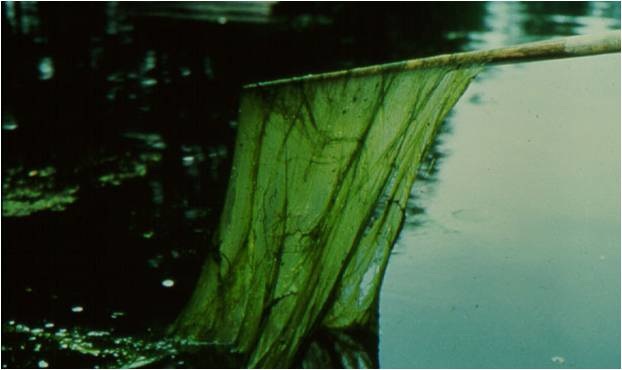 The small, red shrimp are believed to be Halocridina rubra which are found in tide pools of Hawaii (see email below). They can live up to 20 years, grow to 1.5 cm and survive well in a variety of conditions. They eat bacteria and algae while serving as food to larger animals.
 The ecosphere also contains bacteria which can only be seen under a microscope. All living organisms, such as shrimp, green algae, bacteria and humans, perform cellular respiration - a process where cells break down the sugar glucose to release energy used for growth, reproduction, movement, digestion, and other processes. Respiration 6O2 + C6H12O6 ----> 6CO2 + 6H2O + Energy Many organisms eat other living organisms, such as plants and animals, to be broken down into glucose and then used in cellular respiration to produce energy. These organisms are referred to as "consumers" since they consume other organisms for food. Other organisms, such as plants, algae and some protists, need to make their own food through photosynthesis. These organisms are called "producers" since they produce their own food. Photosynthesis 6CO2 + 6H2O + Sunlight ----> C6H12O6 + 6O2 The shrimp, algae and bacteria depend on one another for their existence in the ecosphere. Photosynthesis and Respiration are opposite reactions which occur in different organisms inside the ecosphere. Photosynthesis uses carbon dioxide and water in the presence of light to produce sugar and oxygen. Respiration uses sugar and oxygen to produce energy while releasing carbon dioxide and water. The algae produce sugar, which is stored and used for cellular respiration, and oxygen which is released to the water. When the shrimp eats the algae, they break it down through digestion into glucose which is used with the oxygen in the water for cellular respiration to produce energy. Carbon dioxide is released in this process - and then used by the algae in photosynthesis. The bacteria in the ecosphere is a consumer known as a decomposer. It eats waste from the shrimp and algae as food to be broken down into energy through cellular respiration and releases carbon dioxide into the water. The bacteria also release nutrients such as nitrogen into the water as they decompose the waste products. The nutrients are taken in by the algae which in turn is eaten by the shrimp!  The 3 organisms - shrimp, algae and bacteria - are able to live together without any outside help by providing what each needs in perfect balance, or at least close to perfect balance for several years. Jan 2 (2 days ago)
to customer_servi. Hi, I received an ecosphere as a holiday present and would like to know the species of shrimp, algae and bacteria that are used. Thanks! Ecosphere customer service <[email protected]>1:51 PM (1 hour ago) on 1/4/2016 to me Hello, Thanks for your email. The information you are requesting is proprietary. Sincerely, Chris Ecosphere Associates Inc. Manufacturer of Award Winning Closed Ecosystems TXTR-LITE Flexible Stone Veneer 4421 N Romero Rd | Tucson, AZ 85705 (520) 888-0084 phone
0 Comments
Your comment will be posted after it is approved.
Leave a Reply. |
Cindy BenedekSharing a little bit of science in our everyday world . Previous Posts
Email to Class Class Pics on Twitter Reliable Blogging Science of Hockey Prof's Boss Adjunct's Classroom Road Salt and Ice Blog Story - Science! Snow - Climate Change Flood in Ellicott City Reindeer, Moose, Musk-ox Oil, Gold, Power Midnight Sun APES Exam Squirrels Ecosphere-Photosynth/Resp Scientific Method/Vaccines Why I Blog View Meteor Shower Iron Age to Van Gogh - Native/Invasive species Forest to Spa Delaware to Germany/Grow Hedges Space-A Vacation/How Planes Fly Snake in my Yard Assasin Bugs/Japanese Beetles Fire Pit Venus Fly Trap Hummingbird Swallowtail Butterflies Classroom Technology Categories
All
Archives
March 2017
Blogs I Follow:
DNA Science Blog Endless Forms Most Beautiful Schlossini Voyage CrestFest Mom's Big Year |
Photos used under Creative Commons from Hampshire Museums, shawncampbell, jfingas










 RSS Feed
RSS Feed
